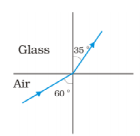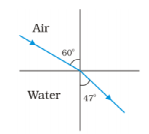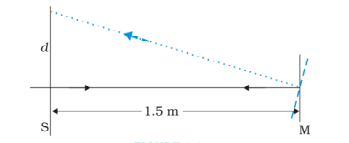EXERCISE from PSEB RAY OPTICS AND OPTICAL INSTRUMENTS for Class 12
| Class 12 | PHYSICS |
| Chapter | RAY OPTICS AND OPTICAL INSTRUMENTS |
| PSEB | EXERCISE |
| Medium | English |
| Academic Year | 2023-2024 |
Question 1
A small candle, 2.5 cm in size is placed at 27 cm in front of a concave mirror of radius of curvature 36 cm. At what distance from the mirror should a screen be placed in order to obtain a sharp image? Describe the nature and size of the image. If the candle is moved closer to the mirror, how would the screen have to be moved?View SolutionQuestion 3
A tank is filled with water to a height of 12.5 cm. The apparent depth of a needle lying at the bottom of the tank is measured by a microscope to be 9.4 cm. What is the refractive index of water? If water is replaced by a liquid of refractive index 1.63 up to the same height, by what distance would the microscope have to be moved to focus on the needle again?View SolutionQuestion 4
Figures (a) and (b) show refraction of a ray in air incident at 60∘ with the normal to a glass-air and water-air interface, respectively. Predict the angle of refraction in glass when the angle of incidence in water is 45∘with the normal to a water-glass interface [Fig. (c)]. :

 View Solution
View SolutionQuestion 6
A prism is made of glass of unknown refractive index. A parallel beam of light is incident on a face of the prism. The angle of minimum deviation is measured to be 40∘. What is the refractive index of the material of the prism? The refracting angle of the prism is 60∘. If the prism is placed in water (refractive index 1.33), predict the new angle of minimum deviation of a parallel beam of light.View SolutionQuestion 12
A compound microscope consists of an objective lens of focal length 2.0 cm and an eyepiece of focal length 6.25 cm separated by a distance of 15 cm. How far from the objective should an object be placed in order to obtain the final image at the least distance of distinct vision (25 cm)? What is the magnifying power of the microscope in?View SolutionQuestion 14
A person with a normal near point (25 cm) using a compound microscope with objective of focal length 8.0 mm and an eyepiece of focal length 2.5cm can bring an object placed at 9.0mm from the objective in sharp focus. What is the separation between the two lenses? Calculate the magnifying power of the microscope.View SolutionQuestion 22
A small pin fixed on a table top is viewed from above from a distance of 50cm. By what distance would the pin appear to be raised if it is viewed from the same point through a 15cm thick glass slab held parallel to the table? Refractive index of glass = 1.5. Does the answer depend on the location of the slab?View SolutionQuestion 23
Figure 9.35 shows a cross-section of a glass fibre of refractive index 1.68. The outer covering of the pipe is made of a material of refractive index 1.44. What is the range of the angles of the incident rays with the axis of the pipe for which total reflections inside the pipe take place, as shown in the figure. : View Solution
View SolutionQuestion 24
Figure 9.35 shows a cross-section of a glass fibre of refractive index 1.68. The outer covering of the pipe is made of a material of refractive index 1.44. What is the range of the angles of the incident rays with the axis of the pipe for which total reflections inside the pipe take place, as shown in the figure. What is the answer if there is no outer covering of the pipe? : View Solution
View SolutionQuestion 32
Determine the ‘effective focal length’ of the combination of the two lenses convex lens of focal length 30cm in contact with a concave lens of focal length 20cm, if they are placed 8.0 cm apart with their principal axes coincident. Does the answer depend on which side of the combination a beam of parallel light is incident? Is the notion of effective focal length of this system useful at all?View SolutionQuestion 33
Two lenses convex lens of focal length 30 cm in contact with a concave lens of focal length 20 cm, if they are placed 8.0 cm apart with their principal axes coincident. An object 1.5 cm in size is placed on the side of the convex lens. The distance between the object and the convex lens is 40 cm. Determine the magnification produced by the two-lens system, and the size of the image.View SolutionQuestion 37
For a normal eye, the far point is at infinity and the near point of distinct vision is about 25cm in front of the eye. The cornea of the provides a converging power of about 40 dioptres, and the leas converging power of the eye-lens behind the cornea is about 20 dioptres. From this rough data estimate the range of accommodation (i.e., the range of converging power of the eye-lens) of a normal eye.View SolutionQuestion 41
A man with normal near point (25 cm) reads a book with small print using a magnifying glass: a thin convex lens of focal length 5 cm- What is the closest and the farthest distance at which he should keep the lens from the page so that he can read the book when viewing through the magnifying glass?View SolutionQuestion 43
A card sheet divided into squares each of size 1mm2 is being viewed at a distance of 9 cm through a magnifying glass (a converging lens focal length 10 cm) held close to the eye. What is the magnification produced by the lens? How much is the area of each square in the virtual image?View SolutionQuestion 49
A card sheet divided into squares each of size 1mm2 is being viewed at a distance of 9 cm through a magnifying glass (a converging lens of focal length 10 cm) held close to the eye. What should be the distance between the object in converging lens and the magnifying glass if the virtual image of each square in the figure is to have an area of 6.25mm2. Would you be able to see the squares distinctly with your eyes very close to the magnifier ?View SolutionQuestion 59
A small telescope has an objective lens of focal length 140 cm and an eyepiece of focal length 5.0 cm. (A) what is the separation between the objective lens and the eyepiece? (B) If this telescope is used to view a 100 m tall tower 3 km away, what is the height of the image of the tower formed by the objective lens?View SolutionQuestion 60
A small telescope has an objective lens of focal length 140 cm and an eyepiece of focal length 5.0 cm. (A) If this telescope is used to view a 100 m tall tower 3 km away, what is the height of the image of the tower formed by the objective lens? (B) What is the height of the final image of the tower if it is formed at 25 cm?View Solution

